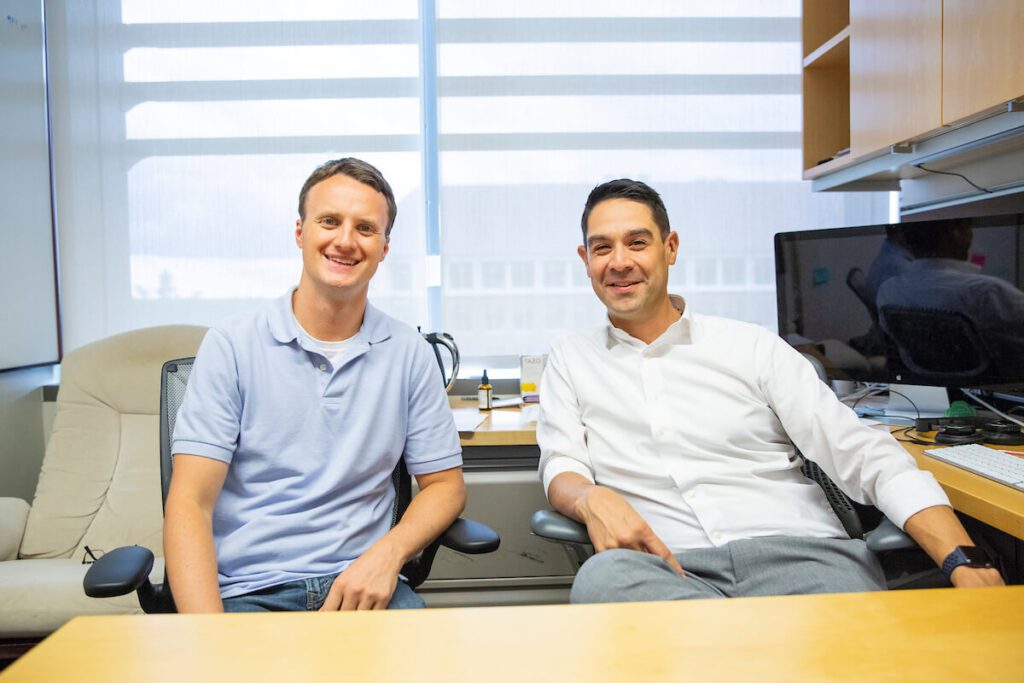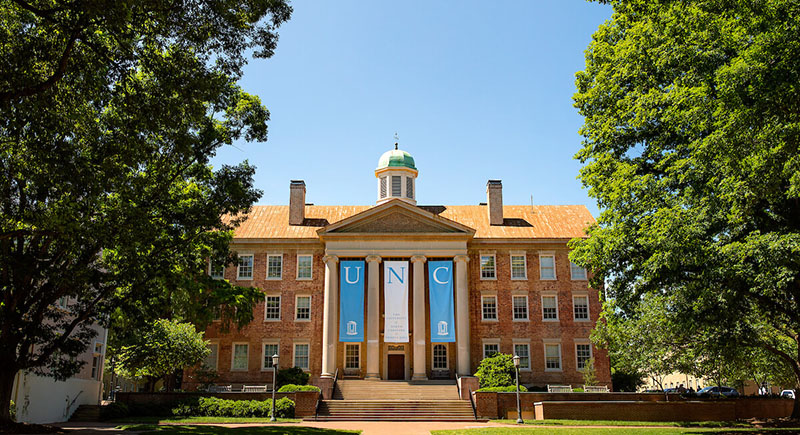
Andrew Satterlee, Shawn Hingtgen and Alison Mercer-Smith (photo by Jeyhoun Allebaugh)
In one Carolina research lab, developing personalized treatments for brain cancer is more than a professional path, it’s a personal mission.
By Courtney Mitchell
In December 2017, Andrew Satterlee, Ph.D., was approaching a major milestone. He planned a party at his house with his friends and family, and he extended that invitation to a big part of his day-to-day life — his colleagues in the cancer research lab.
The occasion? Satterlee — a postdoctoral cancer researcher with a Ph.D. in biomedical engineering from UNC — was marking 10 years cancer free, having been diagnosed with a brain tumor when he was only 20. There would be a piñata in the shape of a brain tumor for him to ceremoniously smash.
Satterlee’s coworker Alison Mercer-Smith, a graduate student working in the lab as she completes her M.D./Ph.D. at Carolina, received the invitation and bee-lined to the tissue culture room to find Satterlee.
“I got an email from Andrew that said, ‘I’m celebrating my 10th year cancer free at my house. Let me know if you can come,’” said Mercer-Smith. “I ran up to him, and I said, ‘Andrew, your 10-year cancer anniversary is coming up. Well, mine is, too.’ It was wild.”
Neither had known they shared something so remarkable: 10 days after Satterlee had been diagnosed with brain cancer in Kansas, Mercer-Smith had been diagnosed with ovarian cancer in New Mexico. And, 10 days after Satterlee was declared cancer free, Smith was cancer free, too.
Though the specifics of their journeys were different, neither of their cancers had been easy to diagnose. And, cancer had come to them both at foundational times in their lives, as they were trying to juggle school, activities and the day-to-day of being young.
Somehow, so many years later, those paths led them both to the cancer research lab of Shawn Hingtgen, Ph.D., an associate professor at the UNC Eshelman School of Pharmacy. Many miles apart they’d beaten cancer together, and now they are working together to cure it.
The lab — funded by both the Eshelman Institute for Innovation and the UNC Lineberger Comprehensive Cancer Center, of which lab director Hingtgen is a member — harnesses the power of stem cell therapy to create personalized treatments for glioblastoma (GBM), the most common and aggressive brain cancer. These unique stem cells seek out and find tumor cells, and they can carry potent drugs to kill cancer cells while leaving the healthy brain unharmed.
Hingtgen did not know that either Saterlee or Mercer-Smith had endured and survived cancer diagnoses when he hired them. But, their presence as both talented, driven scientists and survivors with an eye for patient care has had a significant impact on the lab and his own work, he said.
“Because of them, we’re really raising the bar on cancer research.”

Satterlee grew up in a suburb of Kansas City, Kansas, a typical kid who participated in theatre and played football. After high school, he went to nearby Kansas State University as a chemical engineering major.
In 2007, his sophomore year of college, he developed headaches and nausea, symptoms that don’t traditionally cause alarm. Vertigo, vomiting and fainting came next.
“It turned out to be hydrocephalus,” said Satterlee. “Cerebrospinal fluid washes over the brain and drains into ventricles. But, there was something blocking one of the ducts, so it couldn’t drain, and the pressure in my brain started to go up.”
After seeing a mass on a CT scan, the first doctor thought it was a cyst. A shunt was inserted into his skull to help drain the fluid, and Satterlee went on to finish his fall semester. As his parents sought a second opinion, they learned about Mitchel Berger, M.D., a neurosurgeon at the University of California in San Francisco.
“Dr. Berger was the guy you wanted. He took a look at my scans and said, ‘get out here.’”
Satterlee had a germ cell tumor in his brain, something more commonly seen in pediatric cancer or testicular cancer. His condition was incredibly rare, and there was little research on how to treat it. Satterlee was a full-time sophomore, simply taking a lighter load to accommodate treatment. For one of his research projects at school, he explored the best way to treat germ-cell cancer in the brain.
“The first cancer research I ever did was trying to find a cure for my own brain cancer.”
Theatre was also part of Mercer-Smith’s high-school experience two states west in New Mexico. In 2007, she was a 15-year-old high school student and a talented alto who found herself suddenly singing baritone. She developed tough-to-treat acne and a mustache. Then, her period stopped. Fifteen is a tough time for teenage girls, Mercer-Smith said, and she was no exception. She tried to rationalize the symptoms: allergies had made her hoarse. Bad skin was normal for a teenager.
“Talking became scary because I didn’t know what would come out. People were joking with me that I was turning into a boy. I went to see a dermatologist who prescribed retinoids, and my skin started flaking off, but my acne didn’t get any better. I didn’t know it, but this was because of spikes in testosterone.”
Mercer-Smith knew a regular menstrual cycle was an indicator of health, but her period would vanish for months. Her mother took her to her pediatrician.
“My pediatrician did a lab test and said, you know your estrogen is perfectly fine, but your testosterone is really high. That was really upsetting. The scary part was not knowing why any of this was happening to me.”
Mercer-Smith was referred to a gynecologic oncologist who found masses on her ovaries, which were first deemed benign. The pathology came back as cancer. Because the cancer was detected so early, Mercer-Smith was able to avoid both radiation and chemotherapy with the removal of one ovary and medication management to suppress the remaining one.
“When you’re a teenage girl with cancer, your brain still works like a teenager. I was walking into the hospital on the day of my surgery, and I passed by a boy my age in the lobby. I went in the bathroom and looked in the mirror, thinking about how he probably thought I looked awkward or ugly. In that moment, the possibility of having cancer just paled in comparison to feeling awkward about some stranger boy I didn’t know.”
Both Satterlee and Mercer-Smith were science-minded, high-performing students, but finding cancer-adjacent careers was more of a progression than a deliberate track.
“It’s hard to explain what engineering is,” said Satterlee. “More than a subject I memorized, it’s really a skillset I gained. In research, you have to learn how to design studies, and fail and fail and fail and problem solve, and hope you come out the other side.”
Interested in designing new ways to deliver drugs, Satterlee came to North Carolina to get a Ph.D. in biomedical engineering in a joint program between UNC-Chapel Hill and N.C. State University.
And, as a post-doc in Hingtgen’s lab, he has come full-circle, investigating some of the same procedures that Dr. Berger used on him. Last year Satterlee attended the same conference as his revered surgeon and connected with him as a professional, 10 years after he saved his life.
“He said, ‘let me take a look at that scar,’ and turned me around to look at the back of my head. Here I was at a conference with him, and with Shawn. This is what I do now. The stars just kept aligning.”
Mercer-Smith loved chemistry in high school and considered becoming a doctor — specifically, a pathologist. She often thought about the pathologist who’d diagnosed her tumor as cancer. He was far away, in Massachusetts, and he’d saved her life without even meeting her.
“At first, I thought that I wanted to be a pathologist because they can help people but are more removed from what patients going through.”
In college, Mercer-Smith volunteered with hospice to experience patient care to see if she could be cut out for it.
“That’s when I realized pain is sad, and death is sad, but you don’t have to be afraid of it.”

In Hingtgen’s lab, where she works on transforming skin cells into neural stem cells and testing these therapies, she also spends a few days a month in an oncology clinic. Because these patients are likely going to be getting radiation therapy, she wants to understand how the therapies they are developing will interact with radiation in a real setting.
At the completion of her degrees, Mercer-Smith wants more of the same: “one foot in the lab and one foot in clinic.
“I think that being in clinic gives you a sense of urgency that you might not have otherwise. It humanizes it.”
Hingtgen’s career goal has always been to create a solution in the academic world that would solve an important medical problem. His dream has been to translate his work to the clinic and see it improve the lives of patients.
“It is so much more than, ‘can we kill this cell in a dish? Can we publish this paper?’” he said.
“The majority of cancer researchers could spend a lifetime in the lab and never speak face-to-face with people who have that disease, and that’s an odd experience. Alison and Andrew have the kind of drive and motivation for curing cancer that is reflective of someone who has been through treatment. I can see it in the work they do. They aren’t just designing treatments. They are designing it for someone.”
In the midst of all the lab is doing to move the needle on surviving complicated cancers and improving the quality of life for cancer patients and cancer survivors, Satterlee and Mercer-Smith are, for Hingtgen, living, breathing, thriving reminders of what is possible.
“Having them here with us means their stories are always present for me, keeping us connected to that human cancer patient who needs us to find a cure.”



